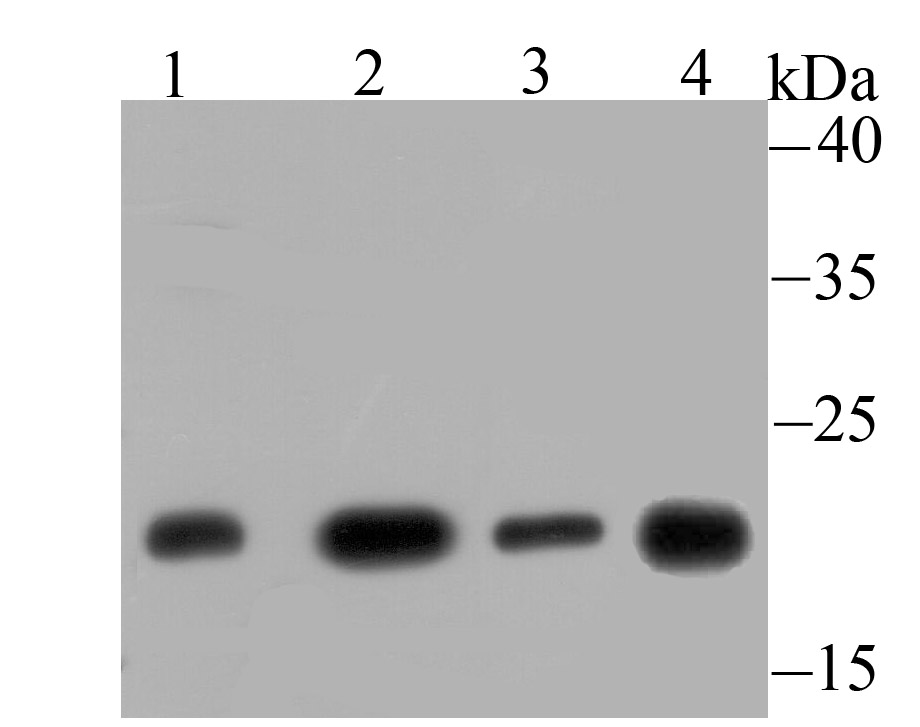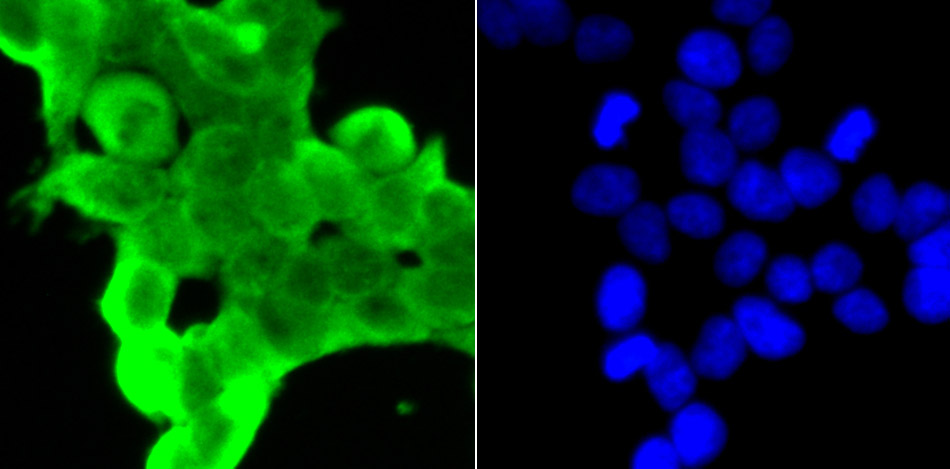Product Name :
GLO1 polyclonal antibody Background :
The glyoxal pathway plays a role in the detoxification of glucose degradation products (GDP). Glyoxalase I (GLO1), a member of the glyoxalase family, is effective in eliminating GDP. Overexpression or silencing of Glyoxalase I in mice brain suggests an association between Glyoxalase I and anxiety. Glyoxalase I has three isoforms generated from two alleles in the genome which forms two homodimers and one heterodimer, each subunit binding one zinc ion. Research demonstrates that GLO1 gene expression is induced in colon carcinoma. Both an insulin response element (IRE), and a zinc metal response element (MRE) in the promoter region of the GLO1 gene have been identified. Product :
Rabbit IgG, 1mg/ml in PBS with 0.02% sodium azide, 50% glycerol, pH7.2 Storage&Stability :
Store at +4°C after thawing. Aliquot store at -20°C or -80°C. Avoid repeated freeze / thaw cycles. Specificity :
GLO1 polyclonal antibody detects endogenous levels of GLO1 protein. Immunogen :
Recombinant protein Conjugate :
Unconjugated Modification :
Unmodification
GLO1 polyclonal antibody Background :
The glyoxal pathway plays a role in the detoxification of glucose degradation products (GDP). Glyoxalase I (GLO1), a member of the glyoxalase family, is effective in eliminating GDP. Overexpression or silencing of Glyoxalase I in mice brain suggests an association between Glyoxalase I and anxiety. Glyoxalase I has three isoforms generated from two alleles in the genome which forms two homodimers and one heterodimer, each subunit binding one zinc ion. Research demonstrates that GLO1 gene expression is induced in colon carcinoma. Both an insulin response element (IRE), and a zinc metal response element (MRE) in the promoter region of the GLO1 gene have been identified. Product :
Rabbit IgG, 1mg/ml in PBS with 0.02% sodium azide, 50% glycerol, pH7.2 Storage&Stability :
Store at +4°C after thawing. Aliquot store at -20°C or -80°C. Avoid repeated freeze / thaw cycles. Specificity :
GLO1 polyclonal antibody detects endogenous levels of GLO1 protein. Immunogen :
Recombinant protein Conjugate :
Unconjugated Modification :
Unmodification
-
 Western blot analysis of GLO1 on different lysates using anti-GLO1 antibody at 1/500 dilution. Positive control: Lane 1: Mouse testis tissue Lane 2: C2C12 Lane 3: 293 Lane 4: Rat spleen tissue
Western blot analysis of GLO1 on different lysates using anti-GLO1 antibody at 1/500 dilution. Positive control: Lane 1: Mouse testis tissue Lane 2: C2C12 Lane 3: 293 Lane 4: Rat spleen tissue -
 ICC staining GLO1 in 293T cells (green). The nuclear counter stain is DAPI (blue). Cells were fixed in paraformaldehyde, permeabilised with 0.25% Triton X100/PBS.
ICC staining GLO1 in 293T cells (green). The nuclear counter stain is DAPI (blue). Cells were fixed in paraformaldehyde, permeabilised with 0.25% Triton X100/PBS.
Bioworld Biotech only provide peptides for our antibodies and do not provide additional peptide customization services.
Price/Size :
USD 368/1mg/vial
Tips:
For phospho antibody, we provide phospho peptide(0.5mg) and non-phospho peptide(0.5mg).Describe :
Blocking peptides are peptides that bind specifically to the target antibody and block antibody binding. These peptide usually contains the epitope recognized by the antibody. Antibodies bound to the blocking peptide no longer bind to the epitope on the target protein. This mechanism is useful when non-specific binding is an issue, for example, in Western blotting (WB) and Immunohistochemistry (IHC). By comparing the staining from the blocked antibody versus the antibody alone, one can see which staining is specific; Specific binding will be absent from the western blot or IHC performed with the neutralized antibody.Formula:
Synthetic peptide was lyophilized with 100% acetonitrile and is supplied as a powder. Reconstitute with 0.1 ml DI water for a final concentration of 10 mg/ml.The purity is >90%,tested by HPLC and MS.
Storage:
The freeze-dried powder is more stable. For short time at 2-8°C. For long term storage store at -20°C.
Note :
This product is for research use only (RUO only). Not for use in diagnostic or therapeutic procedures.
 GLO1 polyclonal antibody
GLO1 polyclonal antibody  Datasheet
Datasheet COA
COA MSDS
MSDS SHIP
SHIP